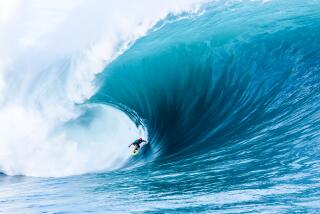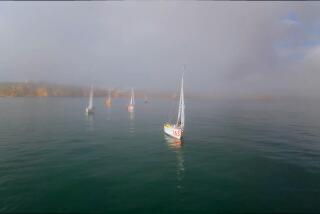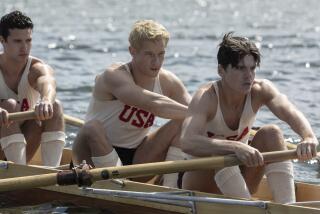America’s Cup Challenge Begins
- Share via
AUCKLAND, New Zealand — After years in planning rooms and laboratories, after months of practice and intrigue, the America’s Cup yachts finally took to the open seas.
The starter’s gun boomed across New Zealand’s Hauraki Gulf on Sunday morning to mark the start of a regatta that will determine which boat will challenge for yachting’s most prestigious trophy in February.
In perfect spring conditions, Ed Baird’s Young America beat the San Francisco Yacht Club’s America True by 37 seconds as the big-spending favorites did well in northeast winds of six to 10 knots.
In other morning races, Japan’s Nippon beat Hawaii’s Abracadabra 2000 by 38 seconds, Italy’s Prada beat the Swiss FAST2000 by 4:20, Dennis Conner’s Stars and Stripes beat Le Defi Francais by nine seconds, and AmericaOne beat the Spanish challenge by 1:09. Young Australia had the bye.
Conner, in his eighth America’s Cup competition, was almost surprised by the French first-timers, who clawed back from a deficit of 1:37 after the second windward mark to almost take the finish when Stars and Strips lost its spinnaker halyard on the last leg.
Conditions became changeable for the afternoon races, with wind shifts common and rain squalls blowing across the bay.
Paul Cayard’s AmericaOne repeated its success in the afternoon, defeating fellow San Franciscan team America True by 3:45. However, America True, with the only female skipper in Dawn Riley, was impressive sailing downwind in both its races.
Prada defeated Nippon in 2:03, Young America defeated the Spanish challenge by 1:49, the French challenge defeated Young Australia by 5:35, and Abracadabra 200 defeated Fast 2000 by 10:17. Stars and Stripes had the bye.
Prada, with the most expensive bid at $50 million, lost mastman Simone de Mari overboard after a gennaker disintegrated at the first mark and were passed on the turn by Nippon. The Italians recovered quickly and passed the Japanese boat on the next leg.
Teams score one point for each win in the first of three round-robins between Oct. 18 and Dec. 12, four points in the second round-robin, nine in the third.
Unless the weather turns bad, all 11 challenging teams will race today over two courses. Team New Zealand, using only two boats to prepare for its defense, has its own course on which to practice.
The Louis Vuitton Cup challenger series will last four months. Seven countries will be represented. The 11 teams are the most of any challenger series except 1987, when 13 syndicates competed.
The winner will take on New Zealand in a best-of-nine series starting in February for yachting’s top prize.
For many teams, preparations began the moment Sir Peter Blake’s Black Magic trounced Conner’s Stars and Stripes in a 5-0 victory off San Diego in 1995.
With cutting-edge technology as important as skilled sailors, team budgets are among the most expensive in the event’s 148-year history.
The New York Yacht Club held the trophy for 132 years until 1983, and the club has spent $40 million on Young America.
AmericaOne won the 1998 Whitbread ‘Round-the World Race on his first try, and Cayard is back for his fifth try for the Cup with a highly rated two-boat campaign based out of San Francisco. He has top crew, including Olympic medalist John Kostecki and J-24 world champion Terry Hutchinson in the afterguard.
America True’s Riley is not new to firsts. She was the first female sailor on the America 3 team in 1992 and the first female skipper with the women’s boat Mighty Mary in 1995. Her one-boat campaign is underwritten by Chicago businessman Chris Coffin; the crew is mixed, with veteran match racer John Cutler, a native New Zealander, at the helm and Leslie Egnot, skipper of the women’s boat in 1995, calling tactics.
In each of three round robins in the challenger series between today and Dec. 12, each team will race all other teams. A boat gets one point for each win in the first round robin, four points in the second, nine in the third.
The best six teams will compete in semifinals in January, and the top two in a best-of-nine series in February. More than 700 races will have been run to determine the challenger.
This is only the second time the America’s Cup has been held outside the United States.
When the 24-inch high silver trophy was paraded through Auckland last week, tens of thousands of cheering people lined the streets.
The Washington Post contributed to this story.


